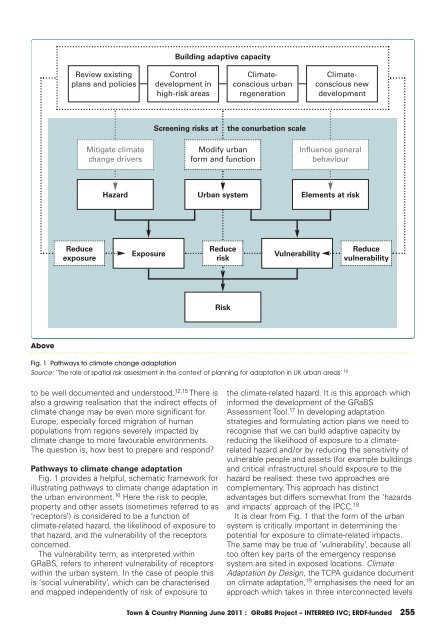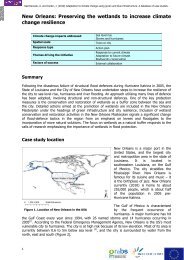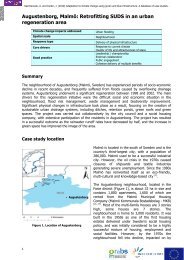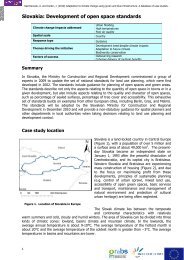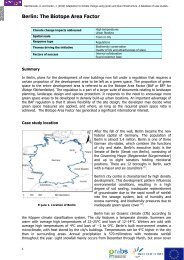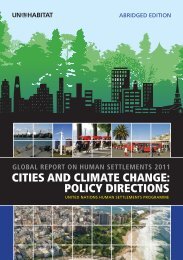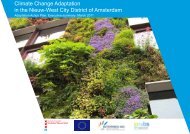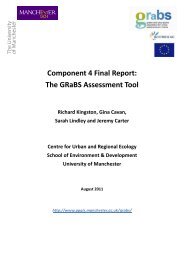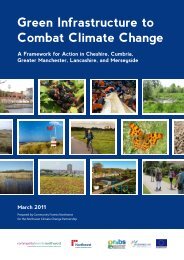Download - GRaBS
Download - GRaBS
Download - GRaBS
You also want an ePaper? Increase the reach of your titles
YUMPU automatically turns print PDFs into web optimized ePapers that Google loves.
Building adaptive capacity<br />
Review existing<br />
plans and policies<br />
Control<br />
development in<br />
high-risk areas<br />
Climateconscious<br />
urban<br />
regeneration<br />
Climateconscious<br />
new<br />
development<br />
Screening risks at<br />
the conurbation scale<br />
Mitigate climate<br />
change drivers<br />
Modify urban<br />
form and function<br />
Influence general<br />
behaviour<br />
Hazard<br />
Urban system<br />
Elements at risk<br />
Reduce<br />
exposure<br />
Exposure<br />
Reduce<br />
risk<br />
Vulnerability<br />
Reduce<br />
vulnerability<br />
Risk<br />
Above<br />
Fig. 1 Pathways to climate change adaptation<br />
Source: ‘The role of spatial risk assessment in the context of planning for adaptation in UK urban areas’ 16<br />
to be well documented and understood. 12,15 There is<br />
also a growing realisation that the indirect effects of<br />
climate change may be even more significant for<br />
Europe, especially forced migration of human<br />
populations from regions severely impacted by<br />
climate change to more favourable environments.<br />
The question is, how best to prepare and respond?<br />
Pathways to climate change adaptation<br />
Fig. 1 provides a helpful, schematic framework for<br />
illustrating pathways to climate change adaptation in<br />
the urban environment. 16 Here the risk to people,<br />
property and other assets (sometimes referred to as<br />
‘receptors’) is considered to be a function of<br />
climate-related hazard, the likelihood of exposure to<br />
that hazard, and the vulnerability of the receptors<br />
concerned.<br />
The vulnerability term, as interpreted within<br />
<strong>GRaBS</strong>, refers to inherent vulnerability of receptors<br />
within the urban system. In the case of people this<br />
is ‘social vulnerability’, which can be characterised<br />
and mapped independently of risk of exposure to<br />
the climate-related hazard. It is this approach which<br />
informed the development of the <strong>GRaBS</strong><br />
Assessment Tool. 17 In developing adaptation<br />
strategies and formulating action plans we need to<br />
recognise that we can build adaptive capacity by<br />
reducing the likelihood of exposure to a climaterelated<br />
hazard and/or by reducing the sensitivity of<br />
vulnerable people and assets (for example buildings<br />
and critical infrastructure) should exposure to the<br />
hazard be realised: these two approaches are<br />
complementary. This approach has distinct<br />
advantages but differs somewhat from the ‘hazards<br />
and impacts’ approach of the IPCC. 18<br />
It is clear from Fig. 1 that the form of the urban<br />
system is critically important in determining the<br />
potential for exposure to climate-related impacts.<br />
The same may be true of ‘vulnerability’, because all<br />
too often key parts of the emergency response<br />
system are sited in exposed locations. Climate<br />
Adaptation by Design, the TCPA guidance document<br />
on climate adaptation, 19 emphasises the need for an<br />
approach which takes in three interconnected levels<br />
Town & Country Planning June 2011 : <strong>GRaBS</strong> Project – INTERREG IVC; ERDF-funded 255


